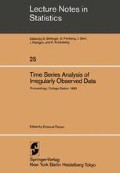Summary
A number of methods for carrying out the maximum likelihood estimation of a dynamic econometric model with missing observations are examined. These include the approach suggested by Sargan and Drettakis and a method based on the EM algorithm. The link between the different methods is explored and it is argued that in all cases the necessary computations can be carried out most efficiently by putting the model in state space form and applying the Kalman filter.
We are grateful to a number of participants in the Symposium for their comments. Particular thanks must go to Robert Shumway, Craig Ansley and Osvaldo Ferreiro. We are also grateful to Frank Dunston and Mark Watson for helpful comments on an earlier draft, particularly on the section dealing with the EM algorithm. We remain responsible for any errors. We would like to thank the SSRC for financial support in connection with the Programme in Methodology, Inference and Modelling in Econometrics at the London School of Economics.
Access this chapter
Tax calculation will be finalised at checkout
Purchases are for personal use only
Preview
Unable to display preview. Download preview PDF.
References
Anderson, B.D.O. and J.B. Moore (1979), Optimal Filtering, Prentice-Hall, Englewood Cliffs.
Dempster, A. P., N.M. Laird and D. B. Rubin (1977), “Maximum Likelihood from Incomplete Data via the EM Algorithm,” Journal of the Royal Statistical Society (B), 39, 1–38.
Drettakis, E.G. (1973), “Missing Data in Econometric Estimation,” Review of Economic Studies, 40, 537–552.
Engle, R.F. and M. Watson (1981), “A One Factor Multivariate Time Series Model of Metropolitan Wage Rates,” Journal of the American Statistical Association, 76, 774–781.
Engle, R.F. and M. Watson (1982), “The EM Algorithm for Dynamic Factor and MIMIC,” H.I.E.R. Discussion Paper, Harvard University.
Hartley, H.O. (1958), “Maximum Likelihood Estimation from Incomplete Data,” Biometrics, 14, 174–194.
Harvey, A.C. (1981), Time Series Models, Phillip Allan, Deddington, and John Wiley/Halstead Press, New York.
Harvey, A.C., C. R. McKenzie, D. Blake and M. Desai (1981), “Data Revisions in the UK,” paper presented at ASA-CENSUS-NBER Conference on Applied Time Series Analysis of Economic Data. To be published in the conference volume.
Harvey, A.C. and C.R. McKenzie (1981), “Estimation of Systems of Equations when there is Contemporaneous Aggregation of Dependent Variables,” London School of Economics Econometrics Programme Discussion Paper No. A.30.
Jazwinski, A.H. (1970), Stochastic Processes and Filtering Theory, Academic Press, New York.
Johnston, J. (1972), Econometric Methods, Second Edition, McGraw-Hill, New York.
Kohn, R. and C. Ansley, “Fixed Interval Estimation in State Space Models When Some of the Data Are Missing or Aggregated,” forthcoming in Biometrika.
Pagan, A. (1980), “Some Identification and Estimation Results for Regression Models with Stochastically Varying Parameters,” Journal of Econometrics, 13, 341–363.
Rosenberg, B. (1973), “Random Coefficient Models: The Analysis of a Cross-Section of Time Series by Stochastically Convergent Parameter Regressions,” Annals of Economic and Social Measurement, 2, 399–428.
Sargan, J.D. and Drettakis, E.G. (1974), “Missing Data in an Autoregressive Model,” International Economic Review, 15, 39–58.
Schweppe, F. (1965), “Evaluation of Likelihood Functions for Gaussian Signals,” IEEE Transactions on Information Theory, 11, 61–70.
Author information
Authors and Affiliations
Editor information
Editors and Affiliations
Rights and permissions
Copyright information
© 1984 Springer-Verlag Berlin Heidelberg
About this paper
Cite this paper
Harvey, A.C., McKenzie, C.R. (1984). Missing Observations in Dynamic Econometric Models: A Partial Synthesis. In: Parzen, E. (eds) Time Series Analysis of Irregularly Observed Data. Lecture Notes in Statistics, vol 25. Springer, New York, NY. https://doi.org/10.1007/978-1-4684-9403-7_6
Download citation
DOI: https://doi.org/10.1007/978-1-4684-9403-7_6
Publisher Name: Springer, New York, NY
Print ISBN: 978-0-387-96040-1
Online ISBN: 978-1-4684-9403-7
eBook Packages: Springer Book Archive

